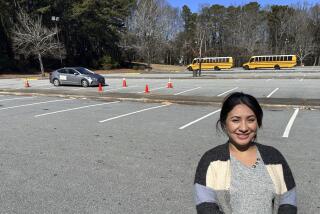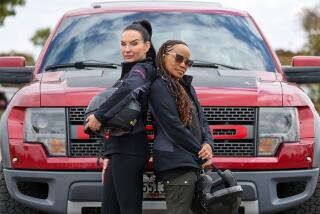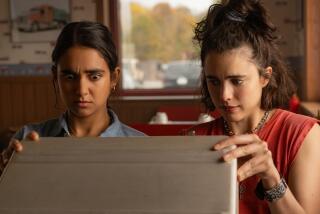Grown-up humor, sensitive story, costar chemistry fuel ‘Learning to Drive’
A film about lessons big and small, in “Learning to Drive” New York literary critic Wendy Shields (Patricia Clarkson) decides she must finally learn to drive after a divorce. Her instructor, Darwan Singh Tur (Ben Kingsley) is himself undergoing a transition as he prepares for his impending arranged marriage. In their time together both in and out of the car, each becomes less set in his and her ways as Wendy and Darwan come to learn that life lessons are a two-way street.
Based on an essay that appeared in the New Yorker in 2002 by Katha Pollitt based on her own experience, the film took about nine years to come to the screen, shepherded by Clarkson and producer Dana Friedman.
“I was always taken by the essay,” Clarkson said. “I just thought it was funny, I thought it was genuinely funny, adult, intricate and had just enough melancholy to make me really love it. It just worked for me.”
SIGN UP for the free Indie Focus movies newsletter >>
The film also falls in with a recent run of films starring actresses such as Blythe Danner, Meryl Streep and Lily Tomlin in which personal growth can come at any stage of life.
“What I like best about this film is this isn’t another story of another woman finding herself,” said the Oscar-nominated, Emmy-winning Clarkson. “My generation of women, we don’t need to find ourselves, we know ourselves. What Wendy finds through Darwan is a better self. She just needed to look up.”
Screenwriter Sarah Kernochan changed the driving instructor from Filipino in the original story to that of a Sikh Indian, adding different layers to the character, including political asylum and arranged marriage. While Clarkson’s co-star, Kingsley, may have a somewhat flashier role in his transformation into a Sikh cab driver and driving instructor, Clarkson was still plenty challenged by the character of Wendy.
“She has a lot going on,” she said. “Scenes that have to go high and low, in a moment. She’s a mercurial woman, and it required the best of me in every moment. I had to dip and weave, every second. It was so funny and tragic, sometimes simultaneously.”
When the film, now playing in Los Angeles, premiered at last year’s Toronto International Film Festival it was runner-up for the coveted audience award behind winner “The Imitation Game.” In a recent review in the New York Times, Stephen Holden said “Learning to Drive” has “a lighthearted gloss to a delicate film that steers clear of preaching or of slipping into mawkishness.” In the Los Angeles Times, Michael Rechtshaffen said the film makes for “a welcome, grown-up escape from all that summer escapism.”
The film reunites Clarkson and Kingsley with Spanish director Isabel Coixet. The trio previously worked together on the 2008 Philip Roth adaptation “Elegy,” which also starred Penelope Cruz, and that film had a much different tone and feel than “Learning to Drive.”
In fact, Coixet, whose other films include 2005’s “The Secret Life of Words” and “Nobody Wants the Night,” which premiered earlier this year at the Berlin International Film Festival, acknowledged that the warm, gentle tone of the “Learning to Drive” was for her something new.
“I have made really dark and sad and melancholy movies. I knew from the beginning that to me this had to be different,” Coixet said. “I have to say, for me, for my nature, it wasn’t easy. It’s easy to find the tragedy and find the dark aspects of human nature.
“For me it was probably the most difficult film I’ve ever done. My instincts go the exact opposite way.”
Also notable about the film is that it is co-edited by Oscar-winner Thelma Schoonmaker, who in recent years has worked less frequently outside her storied collaboration with Martin Scorsese. Sharing credit with Paul Hicks on the film’s original music is Dhani Harrison, son of the late George Harrison.
Both Kingsley and Clarkson noted that part of the reason they were drawn to working with Coixet again is her unusual technique of operating the camera herself. That often puts the director in close proximity to her actors, as Coixet was at times stuffed in the back seat of a car with the actors in the front, Clarkson actually driving.
“I feel that I’m telling Isabel a story, on a highly personal level,” Kingsley said. “And I know that it is going into her lens and into her eyepiece. It is very different from other experiences when the director, for whatever reason, may be 20 yards away in a trailer watching a monitor.”
“She is truly present,” Clarkson said. “She sees everything, she sees it all. She’s right there. I find it comforting; it’s not an intrusion. I know she’s going to truly see it.”
In creating the character of Darwan, Kingsley did not do the sort of actorly research or spending time in a specific community one might expect.
“I learn my lines,” Kingsley said. “I learn his story, and then everything else falls into place intuitively.”
There was a Sikh technical advisor on set to help Kingsley properly wrap his turban, and the actor drew from the Sikh driver and bodyguard he still strongly remembers while shooting his Oscar-winning title role in 1982’s “Gandhi.”
He added, “I love changing my body language and my voice. I think if I find the voice, I hopefully find where it comes from in his body and things do adjust. Once I’ve chosen a character, it’s almost in my DNA.”
And though Wendy and Darwan come to have deep feelings for one another, each having taught the other something along the way, the film keeps their relationship outside the realm of romance.
“This is not a chaste love affair,” Clarkson said. “The truth of the matter is, it is really a beautiful story about friendship.”
Though the film took a number of years to bring to fruition, having it come out at this moment could hardly seem better. A recent USC study found that, of the top 100 grossing films of 2014, there were 21 films with a female lead or co-lead but that none of those roles were for a character 45 or older.
Yet this year such films as “I’ll See You In My Dreams” starring Blythe Danner, “Ricki and the Flash” starring Meryl Streep and “Grandma” starring Lily Tomlin have all featured as their lead roles characters well past their ingénue years.
“I think people just realize there is an audience for this,” Clarkson said. “There are men and women of a certain age who want to see films that represent them and they can relate to. And that they can genuinely laugh at and maybe genuinely shed a tear over. Because it’s still rare.”
Follow me on Twitter at @IndieFocus and subscribe to my Indie Focus film newsletter
MORE:
David McCallum from ‘U.N.C.L.E.’ talks about NCIS and his glory days as a spy
‘Digging for Fire’s’ Rosemarie DeWitt: ‘I wasn’t a good ingenue’
Barry Bostwick still busy 40 years after ‘Rocky Horror’
More to Read
Only good movies
Get the Indie Focus newsletter, Mark Olsen's weekly guide to the world of cinema.
You may occasionally receive promotional content from the Los Angeles Times.







